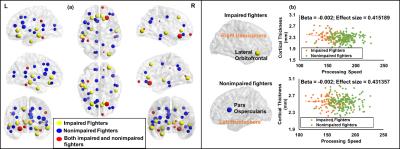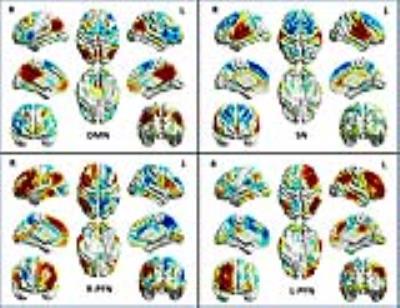Monday, 24 April 2017
| Room 313A |
08:15 - 10:15 |
Moderators: Andre Obenaus, Sheng-Kwei Song |
Slack Channel: #s_neuro
Session Number: O05
08:15
 |
0047.
 |
Disrupted topological brain organizations in large-scale cortical networks between impaired and nonimpaired active fighters 
Virendra Mishra, Sarah Banks, Charles Bernick, Dietmar Cordes
Several MRI studies have shown structural differences in athletes with repetitive head trauma. However, whether coordinated variation exists in brain morphology of cognitively impaired-fighters is still unknown. Using graph-theoretical methods on inter-regional cortical thickness of impaired and nonimpaired fighters, we found alteration in the coordination of the large-scale structural brain-networks of impaired-fighters. The cortical thickness of regions identified as hubs showed a negative association with processing speed in impaired-fighters. Future studies will evaluate the role of network properties in predicting cognitive impairment in active fighters. Our study opens new avenues to understand impact of repetitive head trauma on brain organization.
|
08:27
|
0048.
 |
Connectivity Domain Analysis of Mild Traumatic Brain Injury: A Multi-center Study to Extract Robust Imaging Biomarkers 
Armin Iraji, Jiachen Zhuo, Natalie Wiseman, Ali-Reza Mohammadi-Nejad, Rao Gullapalli, Zhifeng Kou, E. Mark Haacke
Identification of biomarkers for mild traumatic brain injury (mTBI) diagnosis and outcome prediction is challenging due to the heterogeneity of mTBI patients. Multi-center studies help to alleviate this, but functional MRI data can be difficult to combine across sites. Here, we applied our recent connectivity domain (CD) framework and indentified predictive features of mTBI diagnosis and one-month outcome. Despite high heterogeneity of predictors between and within sites, classification accuracy did not suffer due to combination of datasets. Further multi-center analyses may benefit from use of the CD for generation of classification and outcome prediction models.
|
08:39
|
0049.
 |
Diffusion Kurtosis Imaging in mild TBI patients – a Longitudinal Study 
Jonathan Sperl, Xia Li, Chitresh Bhushan, Asha Singanamalli, Ek Tan, Sumit Niogi, A. John Tsiouris, Teena Shetty, Pratik Mukherjee, Joseph Masdeu, Luca Marinelli
Diffusion Kurtosis Imaging (DKI) allows for studying microscopic changes in human brain tissue. In traumatic brain injury (TBI), this may include axonal stretching, shearing, or swelling. Particularly in mild TBI cases, effects can be subtle and standard imaging modalities fail. We study DKI in 68 mild TBI patients with normal structural imaging in a series of four exams over a 90-day period. Using tract-based spatial statistics (TBSS) we observed increased kurtosis five to ten days post-injury followed by decreased kurtosis three months later. Diffusion tensor metrics such as fractional anisotropy in this study lack the sensitivity to track microstructural changes.
|
08:51
|
0050.
 |
Acute white matter abnormalities in sport-related concussion: A DTI study 
Sourajit Mitra Mustafi, Jaroslaw Harezlak, Kevin Koch, Andrew Nencka, Timothy Meier, Andrew Saykin, Micheal McCrea, Thomas McAllister, Yu-Chien Wu
In the present study, we use diffusion tensor imaging (DTI) to detect acute white matter alterations in football players after sport-related concussion. DTI scans were performed on 30 male football players who had acute concussion (24-48 hours post-injury). Another 28 matched contact-sport players were recruited as controls. Mean diffusivity (MD) increased significantly in concussive group compared to the contact-control group. Long fibers including corpus callosum, corona radiata, and longitudinal fasciculus were more vulnerable than the rest of the brain white matter. Within the concussed group, axial diffusivity (AD) demonstrated positive correlation with symptom severity indicating potential axonal changes/damage.
|
09:03
|
0051.
 |
Long Term Changes in White Matter Following Sport-Related Concussion Measured by Diffusion Kurtosis Tensor Imaging: 6 months follow up 
L. Tugan Muftuler, Daniel Olson, Melissa Lancaster, Michael McCrea
We investigated chronic white matter changes in high school and collegiate football players with history of sport-related concussion using diffusion kurtosis tensor imaging. Results demonstrated that the symptoms normalized after one week but, mean diffusivity remained significantly low in concussed football players. These findings have implications for determination of recovery following concussion.
|
09:15
 |
0052.
 |
Diffusion Tensor Imaging Reveals Persistent Effects on White Matter Microstructure in High School Football Players with History of Sports-Related Concussion 
Ikbeom Jang, Yukai Zou, Eric Nauman, Thomas Talavage
Diffusion Tensor Imaging has been considered a promising and sensitive imaging technology to detect subtle changes in white matter for people with mild traumatic brain injury. Although many studies have examined the immediate and near-term brain changes associated with sports-related concussions, the potential long-term consequences have been less-frequently investigated. In this study, a retrospective analysis was conducted on a subset of the Purdue Neurotrauma Group database to characterize the relationship between history of concussion and white matter diffusion properties.
|
09:27
|
0053.
 |
Alterations in Brain Functional Connectivity and Global Cerebral Blood Flow in Collegiate Football Athletes over a Single Football Season 
David Zhu, Peter Seidenberg, Tim Bream, Alexa Walter, Xiaoxiao Bai, Brian Johnson, Hans Breiter, Thomas Talavage, Semyon Slobounov
There has been growing concern over sports-related brain injuries and their long-term effects. However, the cumulative effect on the brain of sub-concussive hits is still poorly understood. Eighteen male collegiate student football athletes completed multi-modal MRI scans before and after a football season. We found significant changes of functional connectivity to the default-mode network, along with significant increase of cerebral blood flow both globally and at the postcentral gyrus. These changes point to the need for further investigation of the long-term development of brain networks in the presence of sub-concussive hits, and the potential relationship with brain vascular modification.
|
09:39
|
0054.
 |
Combined DTI-derived metrics capture acute structural alterations in sports-related mild TBI (mTBI) 
Arun Venkataraman, Samuel Tomlinson, Steven Meyers, Jeffrey Bazarian, Jianhui Zhong
Traumatic brain injury (TBI) is a source of considerable cost to society. Measures have been taken to increase awareness of possible injury, with safety precautions following suit. Despite this vigilance, the possibility of underdiagnosis is a reality. In this abstract, we seek to explain DTI-derived metrics and their application in the clinical setting. Tract based spatial statistics (TBSS), brain segmentation, and network analysis were applied to TBI and healthy cohorts to derive metrics that could aid in the diagnosis of mild TBI (mTBI), and provide a mechanism for quantification of severity and risk stratification.
|
09:51
 |
0055.
 |
Evaluation of Myelin Damage in Diffuse Traumatic Brain Injury using ViSTa-MWI 
Joon Yul Choi, Ji-Won Baek, Jongho Lee, Junghoon Kim
This study investigated myelin damage in subacute moderate to severe TBI using ViSTa-MWI. The results showed widespread reductions of MWF in patients, consistent with pathology involving diffuse axonal injury. Furthermore, the extent of myelin damage was strongly correlated with measures of injury severity and cognitive impairment, demonstrating its clinical relevance.
|
10:03
|
0056.
 |
White matter changes and correlations with cognitive functions in semi-acute mild traumatic brain injury (mTBI): A hybrid diffusion imaging study 
Sourajit Mitra Mustafi, Chandana Kodiweera, Jaroslaw Harezlak, Laura Flashman, Thomas McAllister, Yu-Chien Wu
In the present study, we used multi-shell Hybrid Diffusion Imaging (HYDI) to study changes in white matter after mild traumatic brain injury (mTBI). From HYDI data, an array of diffusion metrics was computed including diffusion tensor imaging (DTI), neurite orientation distribution and density (NODDI), and return-to-origin (P0) of the q-space analysis. We study between group differences in diffusion metrics and within-group correlations with outcomes of cognitive functions. In addition, we tested the group effects (i.e., interaction or moderation) on the correlations between diffusion metrics and cognitive functions.
|
|












